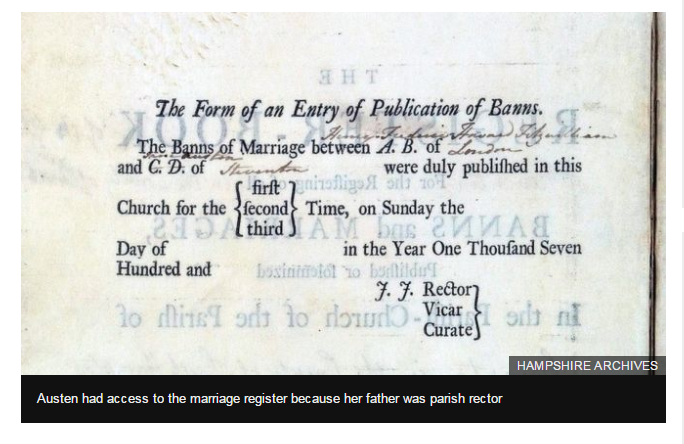Ahhh, see, I told you that notes left in parish registers are endlessly fascinating!
Not only is it possible (at least I think so) that Charlotte Brontë got the surname of her heroine from the printer who manufactured parish registers, but Jane Austen, another vicar’s daughter, was actually writing in the marriage register.
The BBC has reported this as “‘Mischievous’ Jane Austen faked Steventon marriage records” which makes her sound like Sir Percival Glyde in The Woman in White. And there’s more: “Novelist Jane Austen created fake entries in a marriage register linking herself with two separate men, it has emerged.” Blimey! The strumpet! She’s committed both bigamy and fraud!
Well… no. Had she filled out a form in the parish register like so:

She would have been in rather a lot of trouble. From 1754 and the Hardwicke Act, marriages were far more regulated than they had been. At least one of the couple had to be resident in the parish they were marrying in, and the marriage had to be by banns or by licence. Banns were called on three consecutive Sundays in church, or a licence had to be paid for and would involve a fine if it turned out the marriage was illegal. If you were so rich that you owned half the British Isles, you could of course get a special licence and marry wherever the heck you liked. You’d also need two witnesses and a clergyman to perform the marriage, and then the spouses either signed or marked the register. The example above (the marriage of my 6 x gt-grandparents) shows that they got married by licence (Elizabeth was pregnant at the time, so the licence sped things up without having to wait for banns to be called), and they both marked – although note that Elizabeth signed with an E, which suggests she wasn’t quite as illiterate as it might at first appear.[1]Not long after writing this blog I found out, ironically enough, that Elizabeth Cardinall is in fact a distant relative of Jane Austen’s – by marriage, via the Burr family and the 1st … Continue reading
If you look at the BBC article, you can see one of Jane’s works.

She’s written the groom’s name as “Henry Frederic Howard Fitzwilliam” where it says “AB” and added “London” as his abode, and then her own name where it says “CD”, and her home parish as her abode. Would Mr Fitzwilliam, bearer of such a grand name, want to marry by banns, though, one wonders?
Look at that example from 1767, and you’ll notice they’re different forms. On the page that Jane Austen graffitied, you can see the other side of the leaf – the title page of the register – showing through. What she “edited” was the example which was printed at the front of every marriage register, so that clergymen would understand how to follow the new layout. And it’s showing how to lay out the publication of the banns – it’s not a marriage entry.
Perhaps she didn’t expect her father to see it, or perhaps he spotted it and laughed.
It’s certainly a fun thing to find – but it was found, in fact, some time ago (“it has emerged” is rather misleading. This “emerged” years back). It is quite the hyperbolic headline – she falsified a marriage record! Well… she did, but not in quite the way you’d assume from the breaking-news tone.
It does go to show though, what you’ll find in parish registers. Poisonings, death by a bell falling out of a steeple, children born in barns, locals trashing a pulpit, extreme weather, and maybe the graffiti of a vicar’s imaginative teenager daughter.
You’ll be able to see this on display in Winchester from May.
Footnotes
| ↑1 | Not long after writing this blog I found out, ironically enough, that Elizabeth Cardinall is in fact a distant relative of Jane Austen’s – by marriage, via the Burr family and the 1st Duke of Chandos. |
|---|
